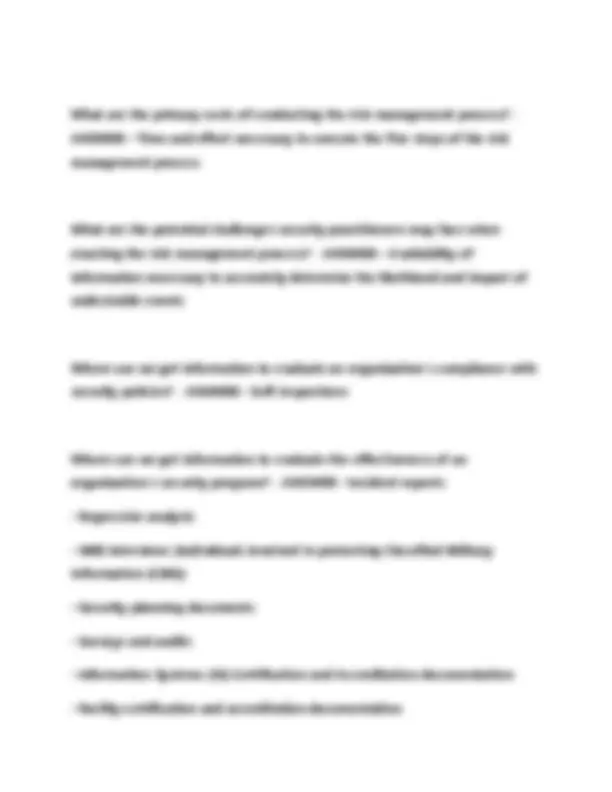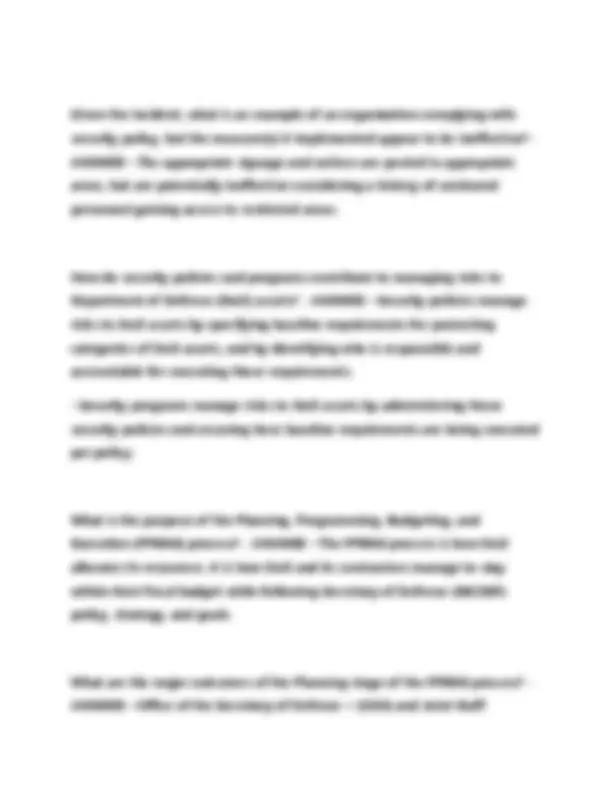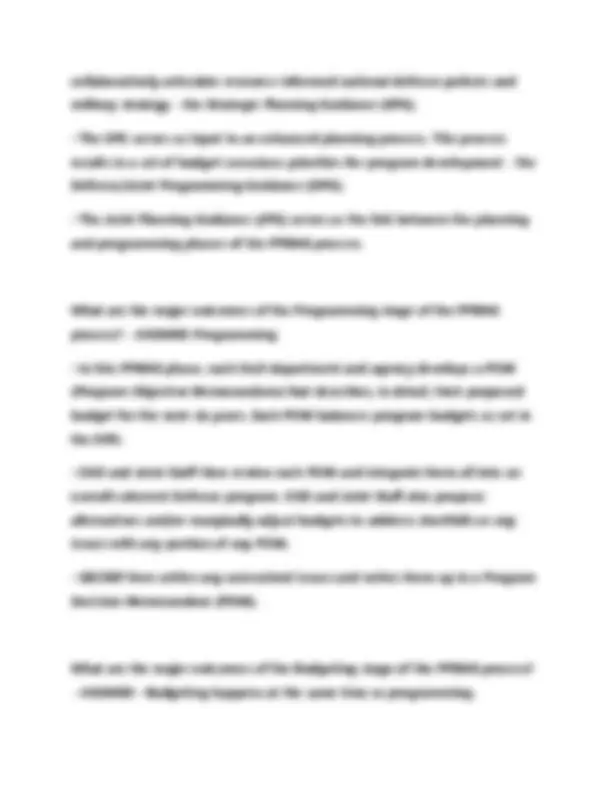






Study with the several resources on Docsity

Earn points by helping other students or get them with a premium plan


Prepare for your exams
Study with the several resources on Docsity

Earn points to download
Earn points by helping other students or get them with a premium plan
Community
Ask the community for help and clear up your study doubts
Discover the best universities in your country according to Docsity users
Free resources
Download our free guides on studying techniques, anxiety management strategies, and thesis advice from Docsity tutors
A comprehensive q&a guide covering key aspects of security risk management and the department of defense's planning, programming, budgeting, and execution (ppb&e) process. it details the steps involved in risk assessment, the purpose of each stage in the ppb&e cycle, and the relationships between these processes. The questions and answers offer valuable insights into security policy compliance, resource allocation, and effective risk mitigation strategies within the dod.
Typology: Exams
1 / 8

This page cannot be seen from the preview
Don't miss anything!





What is the purpose of the asset assessment
step of the risk management process? - ANSWER • Identify assets requiring protection and/or that are important to the organization and to national security
- Identify undesirable events and expected impacts - Prioritize assets based on consequences of loss
What is the purpose of the threat assessment
step of the risk management process? - ANSWER • Determine threats to identified assets
- Assess intent and capability of identified threats - Assess current threat level for the identified assets
What is the purpose of the vulnerability
assessment step of the risk management
process? - ANSWER • Identify existing countermeasures and their level of effectiveness in reducing vulnerabilities
- Identify potential vulnerabilities related to identified assets and their undesirable events - Identify current vulnerability level for the identified assets that can be exploited by the identified threats
What is the purpose of the risk assessment step of the risk management process? - ANSWER • Integrate information about the impact of undesirable events (collected during the asset assessment step) and the likelihood of undesirable events (based on information collected during the threat and vulnerability assessment steps) to determine risks to identified assets
What is the purpose of the countermeasure determination step of the risk management process? - ANSWER • Identify potential countermeasures to reduce vulnerability and/or threat and/or impact
- Identify countermeasure benefits in terms of risk reduction - Identify countermeasure costs - Conduct cost/benefit analysis - Prioritize options and prepare recommendation for decision maker
What is the primary benefit of conducting the risk management process? - ANSWER • National-level security policy endorses a holistic risk management approach, allowing decision makers to effectively allocate resources that provide the necessary security to assets that match the threat to those assets
Given the incident, what is an example of an organization complying with security policy, but the measure(s) it implemented appear to be ineffective? - ANSWER • The appropriate signage and notices are posted in appropriate areas, but are potentially ineffective considering a history of uncleared personnel gaining access to restricted areas.
How do security policies and programs contribute to managing risks to Department of Defense (DoD) assets? - ANSWER • Security policies manage risks to DoD assets by specifying baseline requirements for protecting categories of DoD assets, and by identifying who is responsible and accountable for executing those requirements.
- Security programs manage risks to DoD assets by administering those security policies and ensuring hose baseline requirements are being executed per policy.
What is the purpose of the Planning, Programming, Budgeting, and Execution (PPB&E) process? - ANSWER • The PPB&E process is how DoD allocates its resources. It is how DoD and its contractors manage to stay within their fiscal budget while following Secretary of Defense (SECDEF) policy, strategy, and goals.
What are the major outcomes of the Planning stage of the PPB&E process? - ANSWER • Office of the Secretary of Defense •• (OSD) and Joint Staff
collaboratively articulate resource-informed national defense policies and military strategy - the Strategic Planning Guidance (SPG).
- The SPG serves as input to an enhanced planning process. This process results in a set of budget conscious priorities for program development - the Defense/Joint Programming Guidance (DPG). - The Joint Planning Guidance (JPG) serves as the link between the planning and programming phases of the PPB&E process.
What are the major outcomes of the Programming stage of the PPB&E process? - ANSWER Programming
- In this PPB&E phase, each DoD department and agency develops a POM (Program Objective Memorandum) that describes, in detail, their proposed budget for the next six years. Each POM balances program budgets as set in the DPG. - OSD and Joint Staff then review each POM and integrate them all into an overall coherent Defense program. OSD and Joint Staff also propose alternatives and/or marginally adjust budgets to address shortfalls or any issues with any portion of any POM. - SECDEF then settles any unresolved issues and writes them up in a Program Decision Memorandum (PDM).
What are the major outcomes of the Budgeting stage of the PPB&E process?
metrics, then the execution review may lead to recommendations to adjust the budget or program so it does make those goals.
What is the relationship between the PPB&E process, the President's budget submission to Congress, and Congress's Appropriations process? - ANSWER • The Department submits a two-year • The Department submits a two-year budget estimate to OMB that becomes part of the President's budget request to Congress for even-numbered fiscal years (e.g., the President's Budget submitted to Congress in March 2015 contained the Department's budget estimates and justification for FY 2016 and FY 2017).
- In practice, Congress does not actually provide the Department with a two-year appropriation. It only appropriates funds for the first year. An amended budget justification must be submitted for the second year of the original two-year request so Congress will appropriate funds for that second year.
What roles do the Quadrennial Defense Review (QDR), POM, and Future Years Defense Program (FYDP) play in the PPB&E process? - ANSWER • The QDR is a legislatively-mandated review of DoD strategy and priorities. It sets the long-term course for the DoD by assessing threats and challenges the nation faces and rebalancing DoD's strategies, capabilities, and forces to address today's conflicts and tomorrow's threats. The QDR serves as input to the development of the DPG during the PPB&E planning phase.
- The POM allows each DoD department and agency to describe, in detail, its proposed budget for the next six years. It serves as input to the
Department's overall budget request, provided to Congress as part of the President's budget request. The POM is one of the primary outcomes of the PPB&E programming phase.
- The FYDP summarizes forces, resources, and equipment associated with DoD programs for six years (the current two budgeted years plus four additional years). It is updated twice during the PPB&E cycle: Once to reflect the services combined in the POM submission, and again to reflect the President's Budget submitted to Congress.
Describe what occurs during the even 8. Describe what occurs during the even and odd years of the five-year PPB&E process. - ANSWER • During "on years" (even FY), the Department submits a two- year budget estimate to OMB, which becomes part of the President's budget request to Congress.
- During the "off years" (odd FY), the Department submits an amended budget justification for the second year of the original two-year request to Congress.
How do you get information about resources necessary to implement the Area Commander's decision into the PPB&E process? - ANSWER • Through the POM.